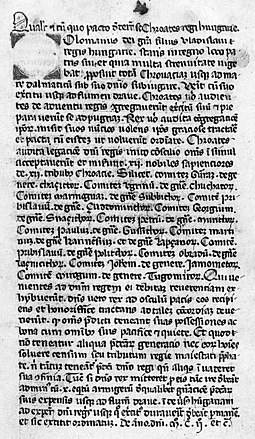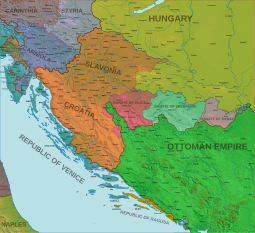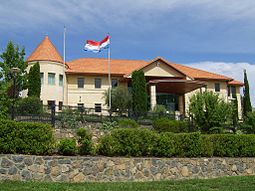Croats
They also form a sizeable minority in a number of neighboring countries, namely Slovenia, Austria, the Czech Republic, Germany, Hungary, Italy, Montenegro, Romania, Serbia and Slovakia.Due to political, social and economic reasons, many Croats migrated to North and South America as well as New Zealand and later Australia, establishing a diaspora in the aftermath of World War II, with grassroots assistance from earlier communities and the Roman Catholic Church.Traditionally, scholarship has placed the arrival of the White Croats from Great/White Croatia in Eastern Europe in the early 7th century, primarily on the basis of the later Byzantine document De Administrando Imperio.[68] Scholars have hypothesized the name Croat (Hrvat) may be Iranian, thus suggesting that the Croatians were possibly a Sarmatian tribe from the Pontic region who were part of a larger movement at the same time that the Slavs were moving toward the Adriatic.[71][72] A closer reading of the DAI suggests that Constantine VII's consideration about the ethnic origin and identity of the population of Lower Pannonia, Pagania, Zachlumia and other principalities is based on tenth century political rule and does not indicate ethnicity,[73][74][75][76][77][78][79] and although both Croats and Serbs could have been a small military elite which managed to organize other already settled and more numerous Slavs,[80][81][82] it is possible that Narentines, Zachlumians and others also arrived as Croats or with Croatian tribal alliance.[88]: 266–276 The lands which constitute modern Croatia fell under three major geographic-politic zones during the Middle Ages, which were influenced by powerful neighbor Empires – notably the Byzantines, the Avars and later Magyars, Franks and Bulgars.In an effort to halt their influence, the Franks sought alliance with the Magyars, and elevated the local Slavic leader Braslav in 892, as a more independent Duke over lower Pannonia.[92][93] After Branimir's death, Prince Muncimir (892–910), Zdeslav's brother, took control of Dalmatia and ruled it independently of both Rome and Byzantium as divino munere Croatorum dux (with God's help, duke of Croats).Tomislav successfully repelled Magyar mounted invasions of the Arpads, expelled them over the Sava River, and united (western) Pannonian and Dalmatian Croats into one state.According to De Administrando Imperio, Tomislav's army and navy could have consisted approximately 100,000 infantry units, 60,000 cavaliers, and 80 larger (sagina) and 100 smaller warships (condura), but generally isn't taken as credible.There Croats under leadership of their king Tomislav completely defeated the Bulgarian army led by military commander Alogobotur, and stopped Simeon's extension westwards.[105] Croatia under Krešimir IV was composed of twelve counties and was slightly larger than in Tomislav's time, and included the closest southern Dalmatian duchy of Pagania.[110][111] He was in conflict with dukes of Istria, while historical records Annales Carinthiæ and Chronica Hungarorum note he invaded Carinthia to aid Hungary in war during 1079/83, but this is disputed.As King Zvonimir died in 1089 in unknown circumstances, with no direct heir to succeed him, Stjepan II (r. 1089–1091) last of the main Trpimirović line came to the throne but reigned for two years.Eventually, the Babonić and Nelipić families also succumbed to the king's offensive against nobility, but with the increasing process of power centralization, Louis managed to force Venice by the Treaty of Zadar in 1358 to give up their possessions in Dalmatia.[citation needed] This resulted in the Bloody Sabor of Križevci in 1397, loss of interest in the crown by Ladislaus and selling of Dalmatia to Venice in 1403, and spreading of Croatian names to the north, with those of Slavonia to the east.At the time they suffered a major defeat in the battle of Krbava field (Lika, Croatia) in 1493 and gradually lost increasing amounts of territory to the Ottoman Empire.Pope Leo X called Croatia the forefront of Christianity (Antemurale Christianitatis) in 1519, given that several Croatian soldiers made significant contributions to the struggle against the Ottoman Turks.Among them there were ban Petar Berislavić who won a victory at Dubica on the Una river in 1513, the captain of Senj and prince of Klis Petar Kružić, who defended the Klis Fortress for almost 25 years, captain Nikola Jurišić who deterred by a magnitude larger Turkish force on their way to Vienna in 1532, or ban Nikola IV Zrinski who helped save Pest from occupation in 1542 and fought in the Battle of Szigetvar in 1566.[citation needed] In the first half of the 17th century, Croats fought in the Thirty Years' War on the side of Holy Roman Empire, mostly as light cavalry under command of imperial generalissimo Albrecht von Wallenstein.In 1664, the Austrian imperial army was victorious against the Turks, but Emperor Leopold failed to capitalize on the success when he signed the Peace of Vasvár in which Croatia and Hungary were prevented from regaining territory lost to the Ottoman Empire.Petar Zrinski, along the conspirators, went on a wide secret diplomatic negotiations with a number of nations, including Louis XIV of France, the Polish–Lithuanian Commonwealth, Sweden, the Republic of Venice and even the Ottoman Empire, to free Croatia from the Habsburg sovereignty.[citation needed] Imperial spies uncovered the conspiracy and on 30 April 1671 executed four esteemed Croatian and Hungarian noblemen involved in it, including Zrinski and Frankopan in Wiener Neustadt.Meanwhile, with the victories over Turks, Habsburgs all the more insistent they spent centralization and germanization, new regained lands in liberated Slavonia started giving to foreign families as feudal goods, at the expense of domestic element.Nevertheless, Ban Jelačić had succeeded in the abolition of serfdom in Croatia, which eventually brought about massive changes in society: the power of the major landowners was reduced and arable land became increasingly subdivided, to the extent of risking famine.[citation needed] Post-war government's policy of easing the immigration of ethnic Croats from abroad encouraged a number of Croatian descendants to return to Croatia.[129] Based on autosomal IBD survey the speakers of Croatian share a very high number of common ancestors dated to the migration period approximately 1,500 years ago with Poland and Romania-Bulgaria clusters among others in Eastern Europe.[citation needed] Folk arts are performed at special events and festivals, perhaps the most distinctive being Alka of Sinj, a traditional knights' competition celebrating the victory against Ottoman Turks.[161] Along the coast, the architecture is Mediterranean with a strong Venetian and Renaissance influence in major urban areas exemplified in works of Giorgio da Sebenico and Niccolò Fiorentino such as the Cathedral of St. James in Šibenik.[170] Region of Slavonia has oldest confirmed CoA, showcasing a marten between rivers Sava and Drava above which is six pointed star and officially granted in 1496 by Vladislaus II of Hungary.






















Croats (military unit)Croatians (demonym)Croat (coin)Croat (surname)Oton IvekovićAdriatic SeaCroatiaBosnia and HerzegovinaUnited StatesGermanyArgentinaAustriaAustraliaCanadaNew ZealandSwitzerlandBrazilSloveniaParaguayFranceSerbiaSwedenHungaryIrelandNetherlandsBoliviaSouth AfricaUnited KingdomRomaniaMontenegroColombiaDenmarkNorwayEcuadorSlovakiaCzech RepublicPortugalRussiaEuropeNorth AmericaSouth AmericaCroatianKajkavianShtokavianChakavianRoman CatholicSouth SlavsKosovoDiasporaBelgiumMacedoniaMexicoVenezuelaBunjevciŠokciBurgenland CroatsJanjevciMolise CroatsKrašovaniCultureLiteratureCinemaCuisineHistoryHistory of CroatiaOriginsRulersLanguageBurgenlandMoliseRelated nationsSouth Slavicethnic groupCentralSoutheastern EuropeancestryWorld War IICatholic Churchnation stateconstituent ethnic groupsHerzegovinaCentral BosniaBosnian PosavinaVojvodinaTarara peopleTe Tai TokerauMāoriNgāpuhiTarara DayMāoridomCatholicsCroatian languageEuropean Unionminority languageCarașovaNames of the Croats and Croatiaethnonymnative nameMedieval LatinNorth-West Slavicliquid metathesisProto-SlavicScytho-SarmatianTanais TabletsProto-OssetianBranimir inscriptionCharter of Duke TrpimirBaška tabletGlagolitic scriptOrigin hypotheses of the CroatsWhite CroatiaWhite CroatsSlavic migrations to Southeastern EuropeEarly SlavsSclaveniDalmatiaIstriaDinaricNoricumDardaniaPrague-Penkovka cultureMiddle AgesGreat/White CroatiaByzantineDe Administrando ImperioAvar hegemony
